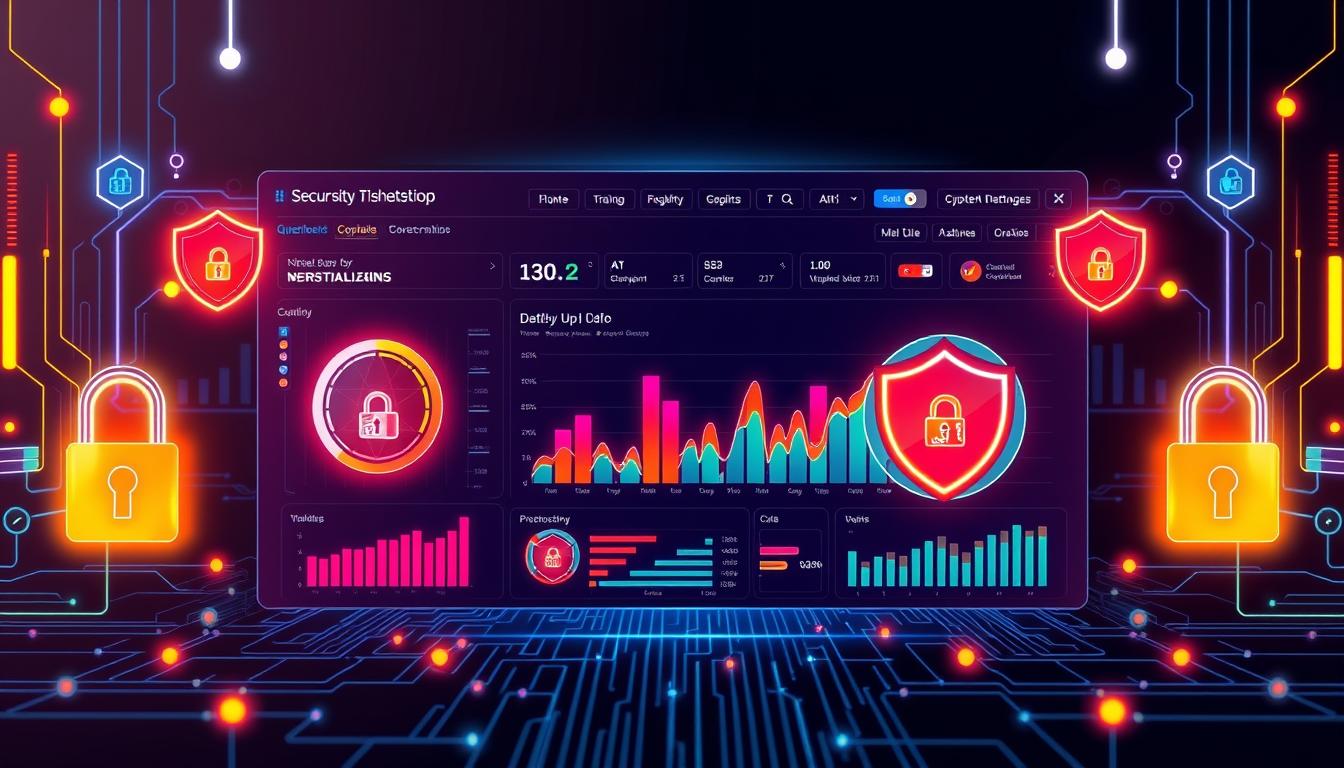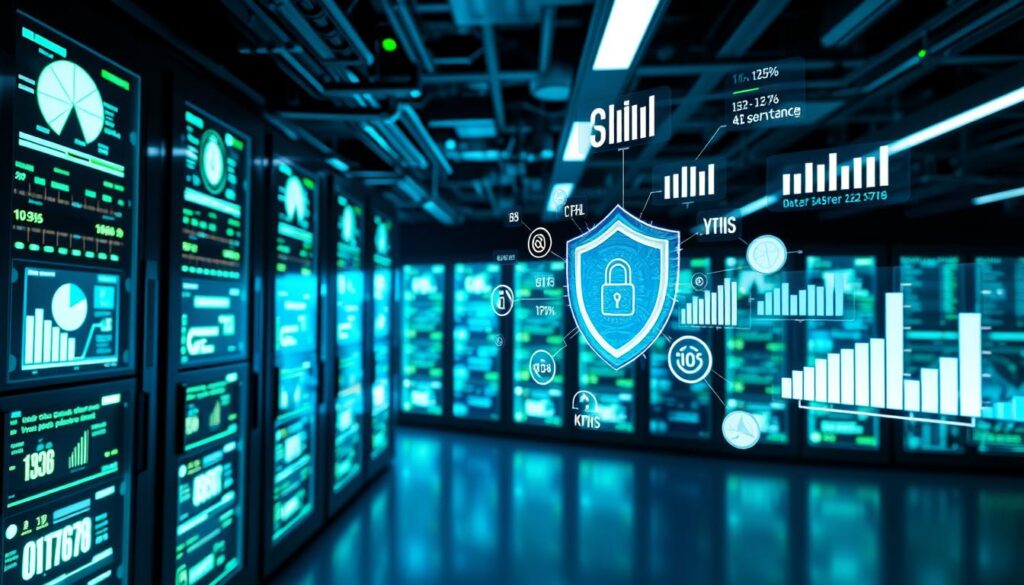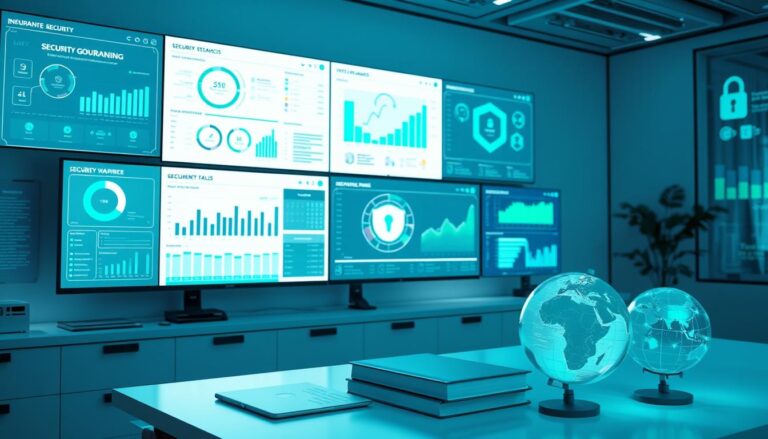
In 2024, almost 98% of organizations have a third party that faced a breach in the last two years. This shows how important good information security governance metrics are. With cyber threats growing, knowing if your security works is key.
By tracking information security metrics, you can spot weak spots and see if your risk management is working. You can also make sure your security plans match your business goals. This helps you make smart choices to protect against cyber attacks.
This article will help you find the best metrics for your cybersecurity efforts. With the right metrics, you can strengthen your defenses and follow industry rules. Let’s explore why measuring success in information security governance is so vital.
The Importance of Measuring Information Security Governance Success
In today’s fast-changing world of cybersecurity, it’s key for companies to understand the role of security metrics. These metrics help track how well security measures work. They ensure that information security governance is strong. By measuring cybersecurity well, you can spot weaknesses, get better at handling incidents, and share the state of cybersecurity with others.
Understanding Why Security Metrics Matter
Good security metrics help make smart choices about cybersecurity spending. Companies struggle to measure things like incident numbers and their effects because there’s no one standard. This makes it hard to really know how risks affect them. For example, figuring out the annualized loss expectancy (ALE) means looking at both possible losses and the chance of those losses happening.
Linking Security Metrics to Business Objectives
It’s important to link cybersecurity to business goals to get support from executives and resources. By showing how security metrics relate to business objectives, you can prove that cybersecurity spending helps the company succeed. Key performance indicators (KPIs) show how well security controls work and what’s okay. Metrics should cover how well things work and if spending is worth it. Being consistent with metrics makes things clear and builds a security-aware culture in the company.
Defining Information Security Governance Metrics
Information security governance metrics are key to measuring how well your cybersecurity is doing. They give you a full picture of how safe your information assets are from cyber threats. Knowing what these metrics are helps you see if your security steps are working.
What Are Information Security Governance Metrics?
These metrics are like signs that show how strong your security is. They check if your security steps are really protecting your assets and fixing weak spots. There are different kinds of metrics, each giving you a unique view of your security.
For example, financial metrics look at how much you spend on security. Operational metrics check if your security processes are running smoothly. And compliance metrics make sure you follow the rules. All these help you build a strong security system.
Types of Metrics and Their Purposes
There are many security metrics to help you understand your cybersecurity better. Here are a few important ones:
- Mean Time to Detect (MTTD): Shows how fast you find a security breach.
- Mean Time to Respond (MTTR): Tells you how long it takes to fix a breach after finding it.
- Patch Management Metrics: Shows how well you keep your systems updated.
- Incident Response Metrics: Checks how good your incident response is.
- Compliance Status: Tracks how well you follow rules like GDPR or HIPAA.
- Phishing Simulation Metrics: Sees how well your training works by testing it in fake attacks.
Knowing these metrics helps you improve your security. By checking them often, you can keep up with new threats. This way, you can make your security investments work better and keep your defenses strong.
Key Performance Indicators (KPIs) for Cybersecurity Measures
KPIs are key to measuring your cybersecurity’s success. They help you see how well your security is working. By tracking these, you can spot what’s working and what’s not. This helps you improve your security plans.
Relationship Between KPIs and Security Effectiveness
Knowing how KPIs relate to security helps you see if your measures are working. For example, Mean Time to Detect (MTTD) shows how fast threats are found. Quick detection means less damage.
Mean Time to Respond (MTTR) is also important. Quick responses help keep risks low. These metrics give you clear data on how well your security is doing.
Common KPIs to Track in Cybersecurity
Keeping an eye on certain KPIs can really help your security. Here are some to consider:
- Incident Response Times: Quick responses to security issues can limit damage.
- Number of Detected and Blocked Attacks: Seeing how many attacks you stop shows your security’s strength.
- Patching Cadence and Effectiveness: Keeping software up to date is key to avoiding vulnerabilities.
- Phishing Test Success Rates: This shows how well your training is working to protect against phishing.
- Unidentified Devices on Networks: Watching these can reveal weak spots in your security.
- Compliance with Security Audits: Regular checks show if your tools and technologies are working right.
It’s important to know that 75% of breaches come from phishing. This highlights the need for strong training. Also, 69% of companies plan to spend more on cybersecurity in 2022. This shows they’re getting the message about the importance of security.
| KPI | Description | Importance |
|---|---|---|
| Mean Time to Detect (MTTD) | Average time taken to detect a security incident | Faster detection leads to swift action |
| Mean Time to Respond (MTTR) | Average time taken to respond to a detected incident | Shorter response times reduce risks |
| Mean Time to Contain (MTTC) | Time taken to shut down attack vectors | Effective containment protects endpoints |
| Patching Cadence | Frequency and effectiveness of software updates | This practice mitigates vulnerabilities |
| Phishing Test Success Rates | Percentage of employees correctly identifying phishing attempts | Measures training effectiveness and reduces human error |
Using these KPIs can make your security better. It helps your organization stay ready for threats.
Data Protection KPIs: Measuring the Integrity of Your Data
Keeping your data safe is key for any organization. Data protection KPIs help track how well you’re doing this. They ensure your data is accurate and meet legal standards.
Identifying Key Data Protection Metrics
Good data integrity metrics are essential. They show how well your data is managed. By tracking these, you can find areas to improve and spot risks early.
- Data Accuracy Rate: Shows how many records are correct.
- Data Completeness: Checks if all needed data fields are filled.
- Data Consistency: Sees if data values are the same across all datasets.
- Data Timeliness/Velocity: Shows how fast data is updated.
- Data Access Compliance: Checks if data access follows security rules.
Evaluating Data Breach Impact and Response Time
Understanding the impact of data breaches is vital. It helps you see how well your response plans work. Key things to look at include:
- Data Breach Incidents: Tracks incidents to measure risk.
- Data Breach Response Time: Sees how fast you respond to breaches.
- Incident Reduction: Shows if fewer incidents happen over time.
- Compliance Scores: Checks if you follow data governance rules.

| Metric | Definition | Importance |
|---|---|---|
| Data Accuracy Rate | Percentage of error-free records | Ensures data reliability for decision-making |
| Data Completeness | Percentage of required data fields filled | Identifies gaps in data collection |
| Data Breach Response Time | Average time to detect and respond | Measures operational efficiency in crisis |
| Data Access Compliance | Adherence to security and privacy policies | Maintains legal and ethical standards |
Risk Management Indicators: Assessing Your Security Posture
It’s key to know what risk management metrics are to check your security level. These metrics help spot, study, and sort risks. This way, companies can focus on the most important cybersecurity steps. By using these metrics, you can see how good your security plans are, helping protect your assets.
Defining Risk Management Metrics
Risk management metrics are tools to measure how well you’re fighting risks. They include:
- Incident Frequency: Watching how many security issues happen helps find weak spots.
- Cost of Breaches: Knowing the money lost in data breaches shows how well you’re doing. A breach can cost about $44.35 million.
- Control Effectiveness: Checking if your security steps really work helps keep risks low.
How to Measure Risk Mitigation Success
To see if your risk fight is working, look at these things:
- Incident Reduction: Good patch management means fewer problems. Those who don’t patch well are 7 times more likely to get hit by ransomware.
- Configuration Assessment: Bad TLS/SSL setups mean big risks. Companies with low grades face almost four times the ransomware danger.
- Credential Monitoring: Watching employee credentials on dark web sites warns of possible breaches.
- Continuous Vendor Monitoring: Regular checks on vendors show changes in risks over time.
In 2023, the world spent over USD 219 billion on IT security. This number is expected to hit over USD 300 billion by 2026. Also, 90% of companies moved to better risk management systems in 2023. Knowing and using risk management metrics well helps improve your security and fight cyber threats.
Compliance Tracking Tools for Information Security
In today’s world, following rules is key to keeping your data safe. It’s not just about following the law; it’s about managing risks and keeping things running smoothly. Using tools to track compliance helps you stay on top of things and react fast to new issues.
The Role of Compliance in Information Security Governance
Following rules like GDPR and HIPAA is a big deal, mainly in healthcare and finance. Tools for tracking compliance help you watch and manage important signs of compliance. They let you see how well your team is doing in training and how vendors are doing, making sure you’re meeting all the rules.
Key Compliance Metrics to Monitor
It’s important to keep an eye on how well you’re doing in following rules. Here are some key things to watch:
| Metric | Description | Optimal Range |
|---|---|---|
| Security Training Completion Rate | Percentage of employees completing security awareness training | Above 90% |
| Incident Response Rate | Percentage of incidents resolved within 48 hours | 90% or more |
| Data Encryption Coverage | Percentage of sensitive data that is encrypted | 100% |
| Access Review Completion Rate | Percentage of user access reviews completed | 95%+ |
| Vendor Compliance Rate | Percentage of third-party vendors adhering to security and compliance requirements | Above 90% |
Using strong tools for tracking compliance gives you a clear view of these metrics. It also helps your organization stay strong over time. The right tools help you quickly adapt to new rules, keeping you safe from big problems.

Understanding Operational Metrics in Information Security
Operational metrics are key to checking if your info security is working well. They give you insights into how good you are at handling cybersecurity tasks. By looking at these metrics, you can see where your security is strong and where it needs work.
Operational Efficiency and Information Security Metrics
Important metrics include:
- Mean Time to Detect (MTTD): This shows how fast your SOC finds security issues. A quick MTTD means you spot threats fast.
- Mean Time to Respond (MTTR): This tells you how long it takes to fix security problems. A low MTTR means your team is quick to act.
- False Positive Rate: Too many false alarms waste resources. A low rate means your detection is good.
- Detection Coverage: This shows how many security issues your tools catch. A high rate means your tools are doing their job well.
- Compliance Metrics: Staying in line with rules lowers legal and financial risks.
- Cost Per Incident: Knowing the cost of security issues helps you make smart choices about spending on security.
How to Use Operational Metrics to Improve Security Posture
To improve security, you need to track important metrics. Start by looking at:
- Security Incident Volume: This shows how many security issues you face. It helps you understand your threat level.
- Mean Time to Investigate (MTTI): This is how long it takes to start looking into a security issue after it’s found.
- Mean Time to Resolve (MTTR): This shows how well you handle fixing security problems. It helps you get better at it.
- Mean Time to Restore Service (MTRS): This tells you how long it takes to get services back after a security issue. It helps you see how much downtime you have.
By watching these metrics closely, you can find where you’re not doing well. Then, you can make your security team better. This way, you can protect your organization from cyber threats more effectively.
| Metric | Description | Importance |
|---|---|---|
| Mean Time to Detect (MTTD) | Average time to identify a security incident. | Indicates efficiency in threat recognition. |
| Mean Time to Respond (MTTR) | Average time taken to contain an incident. | Shows effectiveness in mitigating impact. |
| False Positive Rate | Percentage of alerts that are non-legitimate events. | Reflects accuracy in threat detection. |
| Detection Coverage | Percentage of incidents detected by security tools. | Essential for a strong security posture. |
Cybersecurity Benchmarks: Comparing Your Metrics to Industry Standards
Creating strong cybersecurity benchmarks is key for any organization. It helps you see how your security stacks up against the industry. This way, you can spot where you’re doing well and where you need to get better.
By using benchmarking strategies, you make smarter choices and plan better. This helps you stay ahead in the ever-changing world of cybersecurity.
The Importance of Benchmarking in Security Governance
Benchmarking is a must in cybersecurity. It lets you see where your security falls short compared to others. By looking at metrics like Mean Time to Detect (MTTD) and Mean Time to Respond (MTTR), you can see how fast you catch and fix threats.
Also, knowing how many identities use Multi-Factor Authentication (MFA) shows how secure your access controls are. Regular checks help you get better and stay ready for new threats.
How to Establish Useful Benchmarks
To set good benchmarks, start by picking the right security metrics for your company. Talk to others in your field to learn what’s common, then compare your numbers. This helps you see where you stand.
Keep checking your security regularly. Look at things like how often you do cyber risk assessments and how many high-risk bugs you find. Using frameworks like the NIST Cybersecurity Framework helps you measure and improve your security.
Developing a Framework for Information Security Governance Metrics
Creating a comprehensive metrics framework for information security governance is key. It helps measure and report on security performance. This framework ensures organizations can evaluate their security efforts well. Start by setting clear goals that link to both security and operational aims.
This makes your metrics more meaningful and helps in making better decisions.
Creating a Comprehensive Metrics Framework
Begin by sorting out metrics that fit your organization’s security needs. Most big frameworks say it’s important to set up key performance indicators (KPIs) for security tasks. Think about using metrics like:
- Percentage of applications checked for risks in the last three months.
- Percentage of apps without major or high-risk vulnerabilities.
- Mean Time to Detect (MTTD) and Mean Time to Restore (MTTR) security incidents.
Many organizations spend a lot on digital security but don’t track the benefits. This can lead to not using metrics well because of unclear KPIs. A comprehensive metrics framework makes sure your security efforts match your business goals and how well things run.
Adapting Metrics to Fit Business Needs
Adjusting cybersecurity metrics to fit your business makes them more useful. Every company faces different risks and goals, so it’s key to tailor metrics. To adapt well, consider these steps:
- Find out the main business risks to focus on security.
- Match metrics with your business plans to show the value of security work.
- Keep an eye on security metrics often to make changes and improve.
Using the right metrics helps with reporting and getting ready for audits. Regular checks help understand your security better. This makes your organization stronger against threats. By focusing on developing security metrics that show real security conditions, you can handle information security governance better.
| Metric Type | Description | Importance |
|---|---|---|
| Risk Assessment Coverage | Percentage of applications assessed for risks | Ensures vulnerabilities are identified |
| Incident Response Time | Average time taken to detect and restore | Measures efficiency of incident management |
| Vulnerability Management | Frequency of vulnerability scans | Identifies security weaknesses proactively |
| Compliance Metrics | Adherence to regulations like GDPR | Mitigates legal risks |
Conclusion
Information security metrics are key to making your organization’s cybersecurity stronger. This guide has shown how to measure performance to check risk management and find areas to get better. With a good metrics framework, you can understand your security better, making informed decisions and protecting against cyber threats.
Looking back at the cybersecurity measures, remember the information security world keeps changing. Being proactive with security metrics helps tackle today’s risks and prepares for tomorrow’s. Aligning security strategies with business goals and clear communication with executives boosts your governance.
In today’s world, where cyber threats grow, good information security governance is essential. Tracking and checking key performance indicators helps your organization stay compliant and ready for threats. This leads to a proactive fight against cybercrime.
Source Links
- 22 Cybersecurity Metrics & KPIs to Track in 2024
- 14 Cybersecurity Metrics + KPIs You Must Track in 2025 | UpGuard
- Data Governance Metrics: How to Measure Success – DATAVERSITY
- Key Performance Indicators for Security Governance, Part 1
- Developing Metrics for EffectiveInformation Security Governance
- What are the Information Security Program Metrics?
- What Are Information Security Metrics?
- Top 10 Cybersecurity Metrics and KPIs
- Top 15 Cybersecurity Metrics and KPIs for Better Security
- Top Data Governance KPIs to Measure Success and Drive Growth
- How To Leverage KPIs To Measure And Enhance Data Protection Effectiveness
- 7 Data Governance Metrics and KPIs Every Business Should Track | Secureframe
- What Are Key Risk Indicators? 5 Examples of KRIs
- What is Risk Posture? Assessing and Managing Security Risks
- Top 10 Governance, Risk & Compliance (GRC) Tools
- Top Security Metrics for Info Security Compliance | HyperComply Blog
- What metrics to track for strengthening Security and Compliance for All End-User Devices
- Security Operations Metrics: Definition | Bitsight
- SOC Metrics: Security Metrics & KPIs for Measuring SOC Success | Splunk
- Understanding Cybersecurity Metrics | Teradata
- The Role of Benchmarking in Cyber Risk Management | AuditBoard
- 22 Cybersecurity Metrics & KPIs for Every CISOs
- Metrics-driven Information Security Framework for Effective Information Security Management Governance
- 5 Information Security Metrics That Matter Across Frameworks | Axonius
- Key Performance Indicators for Security Governance, Part 2: Security Reporting for Senior Management
- How to Track Cybersecurity Performance in 2025: Essential KPIs for Businesses
- Information Security Governance Roles and Responsibilities



